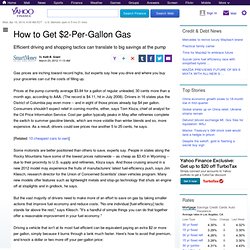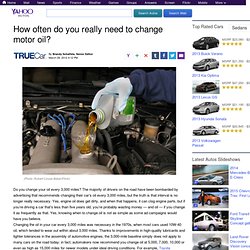

5 money-saving DIY tips for car owners. As cars have become more advanced over time, it has been increasingly difficult for enterprising owners to perform basic maintenance and repairs.

While some jobs do require professional expertise and pricey tools, there are still many things that a handy owner can do to keep a car running in top shape and save money in the process. Below are a few tips from our automotive experts. 1) Treating hazy headlight lenses. Modern headlight assemblies usually have clear plastic covers that can grow hazy over the years from exposure to the elements. To save the expense of changing the whole headlight reflector assembly, you can use a restoration kit, usually consisting of abrasive cloths and a special finishing liquid. 2) Windshield wipers. 3) Wash and wax your car. 4) Light bulbs. 5) Touch-up paint.
10 Outrageous New-Car Scams To Avoid. For many families, buying a car is among the most expensive – and emotional – purchases they’ll ever make.

But while many astute shoppers may come to the table fully prepared with reams of reviews and pricing information on the makes and models of their dreams, they could well face a rude awakening at the hands of a shady, even unscrupulous salesperson or new-car dealership. “People can get into trouble because no one has ever taught them how to really go about buying a car,” says former car dealer and current consumer advocate and radio show host Nicole Markson. “People are not skilled at negotiating because they do it once every three to five years, while dealership personnel do it all day every day. The field is not level from the start.” According to the Better Business Bureau, issues with new-car dealers remain among the top consumer complaints, and even a cursory investigation on the topic opens the proverbial floodgates to torrents of woeful tales. 10. 9.
4 Gas-Saving Myths to Ignore. NEW YORK (MainStreet) -- There are a lot of smart ways to save on gas.

For instance, you can use a Web site such as GasBuddy to find cheaper gas stations in your area, buy a more fuel-efficient vehicle or drive less aggressively so your car uses less gas. These are all proven methods for reducing how much you need to budget for gas, but there are other widely used methods that don't pass the smell test. Here are a few. Buy gas early in the morning.Gasoline is denser at colder temperatures, so the theory here is that if you fill up early in the morning while it's still cool out, you'll get more bang for your buck -- a gallon of gas bought cold will expand to be a little more than a gallon when it gets warmer. But as we explained in our look at common car myths, gas at gas stations is stored in underground tanks, where the temperature varies a lot less than it does on the surface. Overinflate your tires. Turn off the air conditioning and lower the windows.
Leave your tailgate down. How to Get $2-Per-Gallon Gas. Gas prices are inching toward record highs, but experts say how you drive and where you buy your groceries can cut the costs of filling up.

Prices at the pump currently average $3.84 for a gallon of regular unleaded, 30 cents more than a month ago, according to AAA. (The record is $4.11, hit in July 2008). Drivers in 16 states plus the District of Columbia pay even more -- and in eight of those prices already top $4 per gallon. Consumers shouldn't expect relief in coming months, either, says Tom Kloza, chief oil analyst for the Oil Price Information Service. Cost per gallon typically peaks in May after refineries complete the switch to summer gasoline blends, which are more volatile than winter blends and so, more expensive.
[Related: 10 cheapest cars to own] Some motorists are better positioned than others to save, experts say. But the vast majority of drivers need to make more of an effort to save on gas by taking smaller actions that improve fuel economy and reduce costs. By the U.S. How often do you really need to change motor oil? (Photo: Robert Couse-Baker/Flickr) Do you change your oil every 3,000 miles?

The majority of drivers on the road have been bombarded by advertising that recommends changing their car's oil every 3,000 miles, but the truth is that interval is no longer really necessary. Yes, engine oil does get dirty, and when that happens, it can clog engine parts, but if you’re driving a car that’s less than five years old, you’re probably wasting money — and oil — if you change it as frequently as that. Yes, knowing when to change oil is not as simple as some ad campaigns would have you believe. Changing the oil in your car every 3,000 miles was necessary in the 1970s, when most cars used 10W-40 oil, which tended to wear out within about 3,000 miles.